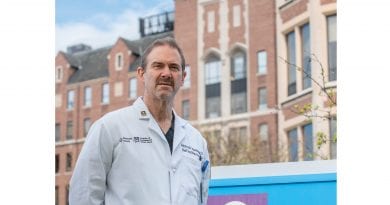Meeting an Emergency Need – Holyoke Medical Center to Unveil New ER This Spring
Running an emergency room is more than a numbers game for hospitals, involving a complex weave of triage and treatment to ensure that patients’ needs are met efficiently and effectively.
But the numbers at Holyoke Medical Center … well, they were simply unsustainable.
“The existing ER is designed to see about 25,000 patients per year,” said Carl Cameron, the hospital’s chief operating officer. “We saw almost 43,000 last year in that small area located in the back of the hospital, which is difficult to find.”
When Spiros Hatiras came on board as president and CEO of Holyoke Medical Center (HMC) in 2013, one of the first concerns brought to him by the board of directors was the existing Emergency Department, which desperately needed an overhaul and more space. They talked about expanding the existing ER, but the finances suggested building a new one would make more sense — not to mention that a construction project in a working ER would disrupt patients.
“We started the dialogue about what we are going to do with the ED in October of 2014,” Hatiras said. “We talked about the concept of expanding in place, but the exercise proved to be futile because we’d lose a lot of space with the construction. So we changed course and said, ‘maybe we need a completely new building.’”
The end result of those discussions will be unveiled this spring: A new Emergency Department that will expand the current space from 8,500 square feet to approximately 20,750 square feet. A second floor above the new ER will house a medical office building of 18,000 square feet.
The expansion will increase the ER’s treatment beds from 26 to 40, 12 of those designated as behavioral-health beds, part of a new Crisis Center for Psychiatric Services, segregated from the main ED to give those patients more privacy. The ED will also include two multi-patient trauma rooms, advanced life-saving equipment, six fast-track spaces, and a patient-navigation service as well. “It’s a large increase from where we’re currently at,” Cameron said.
The exterior space will be bigger as well, with room for four ambulances instead of the current two.
Meanwhile, the second floor will be the home of a comprehensive weight and health-management program, including services for bariatric surgery, general surgery, diabetes counseling, behavioral and nutritional education, as well as a patient fitness center.
“It’s a state-of-the-art space up there, with plenty of room,” Cameron said. “One of the rooms is a large auditorium where we can have sessions with bariatric patients.”
The weight-management program, launched last March, has “grown beyond anyone’s imagination,” Hatiras added, noting that it recently saw its 500th new patient. “It’s been amazing, and it continues to grow. This is the result of planning ahead, knowing we’re going to need more space for that program, and potentially more providers.”
With the new ED and medical office building ahead of schedule — the goal of cutting the ribbon in late June may be pushed up to late May — HCN takes a peek into what is now a mesh of steel framing, but promises to become the state-of-the-art emergency area this community hospital has long needed.
Modern Design
Once the decision was made to build a new structure, Hatiras said, discussions began from a blank slate, incorporating current best practices in layout, workflow efficiencies, and design elements.
“Throughout the waiting area, we’re incorporating a lot of natural light and finishes that make it feel more like the lobby of a hotel than a medical space,” he told HCN. “There’s a lot of glass. Most of the treatment rooms are going to have a window where the natural light comes in. And every single one of the treatment rooms is private — no more lying next to somebody else, separated by a curtain.”
Meanwhile, finishes in the behavioral-health area, including materials, colors, and lighting, are meant to promote a decrease in anxiety. “Behavioral-health patients come in to the hospital in an anxious state,” he explained, “and often the environment — the noise, light, colors –— amplifies that instead of toning it down.”
Planners convened a behavioral-health peer group, soliciting input from former patients, to improve their understanding of how behavioral health should be delivered, and those discussions influenced some of the design choices.
Speaking of design, there was also an effort to make the new building match architecturally with its surroundings, which include buildings that date back to the 1800s, so the exterior brick and metal façade will blend in with both HMC’s recently renovated front lobby and the older buildings on campus.
“Not only will this be a functional improvement,” Hatiras said, “but when we’re done, this will be the most beautiful campus in the Valley, and I can say that with confidence, because I know what it will look like, and I’ve seen the other ones.”
Of course, all this function and design costs money, which for years has been a stumbling block to progress, he went on. The current project began with a $13 million to $14 million price tag, which increased to $23.8 million when the second floor was added.
However, approximately $5.5 million is being provided through the federal New Markets Tax Credit program. Hatiras credits U.S. Rep. Richard Neal with helping secure those funds, which will reduce the hospital’s debt service on the project, allowing it to keep healthy reserves and invest in additional health programs.
Meanwhile, HMC also scored a Community Hospital Acceleration, Revitalization, and Transformation (CHART) grant, a state program that promotes care coordination, integration, and delivery transformation to enhance community hospitals in Masachusetts. The $3.9 million grant -— the largest in CHART’s phase 2 round of funding — supports the integration of behavioral-health services in the Emergency Department. Additional financing partners for the project include Valley Health Systems, MassDevelopment, People’s United Bank, JPMorgan Chase, and A.I. Wainwright.
“Our total cost is $15 million, which is fantastic because an independent community hospital doesn’t have access to capital,” Hatiras said. “So to be able to do this for 60 cents on the dollar with the rest being New Markets Tax Credits and grants is really fantastic.”
A recently launched capital campaign seeks another $3 million to further reduce the hospital’s project costs. More than $1 million has been raised to date, with campaign donations to support some of the new ED’s ancillary needs and additional equipment.
Raising the Bar
One of the late additions to the project, piling on some additional cost, is a second entrance from the main hospital via the second floor, which adds functionality and easier patient access to the new building, Hatiras noted. But the most innovative element in the new ED is the emphasis on behavioral health, which is a growing issue across Massachusetts.
“In our existing ED, we didn’t have enough capacity for private behaviorsal-health areas,” Cameron told HCN. “The new location is going to include six private rooms and another six detox chairs. I can imagine those will be full on a daily basis.”
In addition to the new building and new equipment being purchased, Cameron added, the ER will employ a more efficient workflow system that moves patients more quickly through the triage station and into a treatment room. The nursing station will be centralized and have visibility to all the treatment areas, to better keep track of what’s going on with each patient and, again, promote better flow.
Parking has long been an issue at Holyoke Medical Center — really, at what area hospital is it not an issue? — and the new building took over a small parking lot. But at the same time, the hospital created 100 new spots elsewhere on campus and launched a valet service to get patients in and out quickly without having to look for parking, Cameron said. “All that has definitely improved parking for patients.”
Hatiras said hospital leadership is formulating some long-term solutions to the parking issue, but they’re solutions to a good problem — that is, how to create more access to a hospital that has been growing to meet the needs of its community. This fact, he said, should be considered by neighbors who might be annoyed at some of the parking spillover onto side streets while HMC strategizes to create more space on its campus.
“In the three years since we started the effort to revitalize Holyoke Medical Center, we’ve added more than $20 million in revenue and a couple hundred employees,” he said. “Even the neighborhood property values are affected positively by the new emergency room and a thriving hospital.”
That progress has been reflected in some of the hospital’s recent honors, he added, including a Top Hospital Award from the Leapfrog Group in two of the past three years, which is given to more than 100 institutions nationwide for their commitment to patient safety. Selection is based on many areas of hospital care, including infection rates, maternity care, and the hospital’s ability to prevent medication errors.
“We want to raise this institution to a level the neighborhood and the city can be proud of,” Hatiras said.
That the hospital earned such recognition while operating an ER in half its optimal space is a testament to the hospital’s providers, he noted, and the expansion will provide opportunities to further boost that performance.
Local Impact
Hatiras is proud that most of the construction has been subcontracted to local workers.
“We’ve made a huge effort so that most, if not everything, stays local,” he said. “That’s a big shot in the arm, an economic boost for the area, with that work flowing through here.”
There’s also a sense of pride that the expansion is on schedule and on budget, he added.
“We finished design plans in February 2015, and were bidding out to the general contractor and getting financing before Christmas 2015,” he said. “The whole thing was lightning-fast. Everyone worked really hard on something that can sometimes take a half-decade of planning before it even gets off the ground.”
That wasn’t an option at Holyoke Medical Center, where emergency patients had been feeling the squeeze for much too long.




